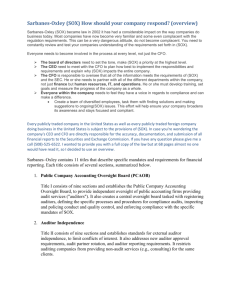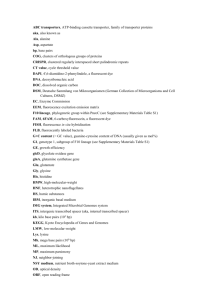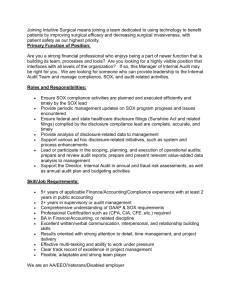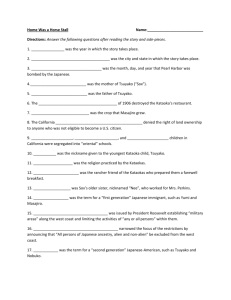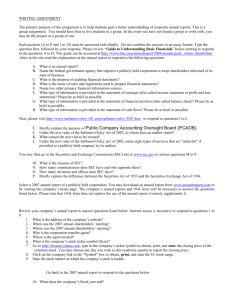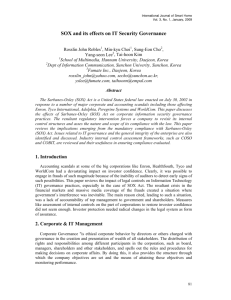Sarbanes-Oxley Act
advertisement
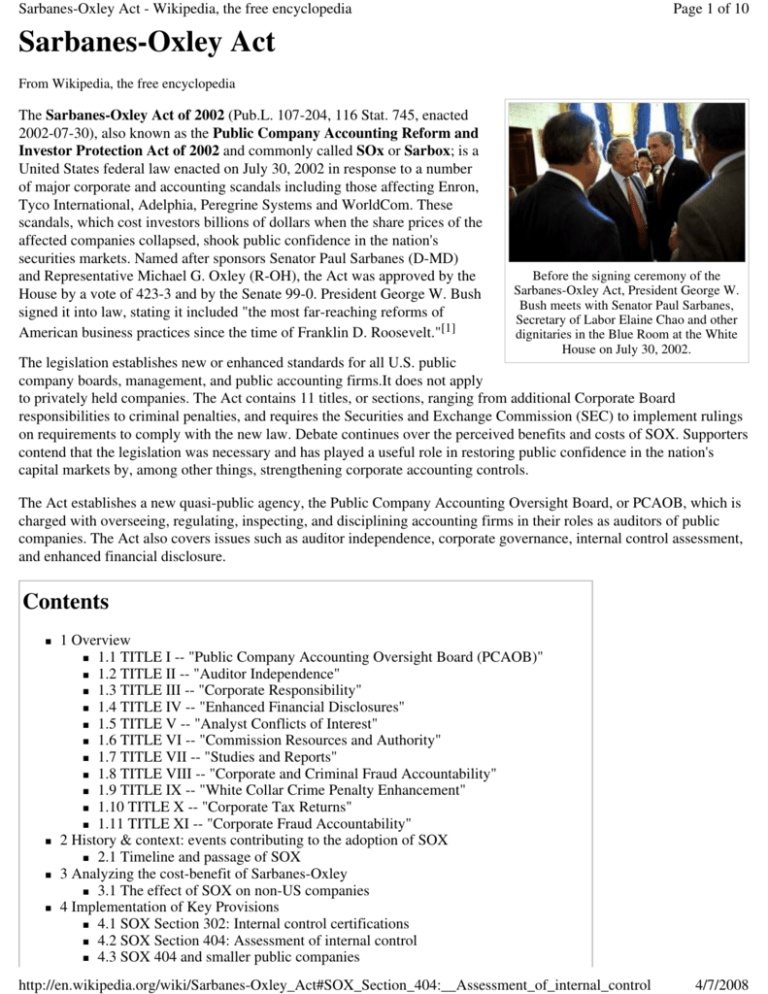
Sarbanes-Oxley Act - Wikipedia, the free encyclopedia Page 1 of 10 Sarbanes-Oxley Act From Wikipedia, the free encyclopedia The Sarbanes-Oxley Act of 2002 (Pub.L. 107-204, 116 Stat. 745, enacted 2002-07-30), also known as the Public Company Accounting Reform and Investor Protection Act of 2002 and commonly called SOx or Sarbox; is a United States federal law enacted on July 30, 2002 in response to a number of major corporate and accounting scandals including those affecting Enron, Tyco International, Adelphia, Peregrine Systems and WorldCom. These scandals, which cost investors billions of dollars when the share prices of the affected companies collapsed, shook public confidence in the nation's securities markets. Named after sponsors Senator Paul Sarbanes (D-MD) and Representative Michael G. Oxley (R-OH), the Act was approved by the House by a vote of 423-3 and by the Senate 99-0. President George W. Bush signed it into law, stating it included "the most far-reaching reforms of American business practices since the time of Franklin D. Roosevelt."[1] Before the signing ceremony of the Sarbanes-Oxley Act, President George W. Bush meets with Senator Paul Sarbanes, Secretary of Labor Elaine Chao and other dignitaries in the Blue Room at the White House on July 30, 2002. The legislation establishes new or enhanced standards for all U.S. public company boards, management, and public accounting firms.It does not apply to privately held companies. The Act contains 11 titles, or sections, ranging from additional Corporate Board responsibilities to criminal penalties, and requires the Securities and Exchange Commission (SEC) to implement rulings on requirements to comply with the new law. Debate continues over the perceived benefits and costs of SOX. Supporters contend that the legislation was necessary and has played a useful role in restoring public confidence in the nation's capital markets by, among other things, strengthening corporate accounting controls. The Act establishes a new quasi-public agency, the Public Company Accounting Oversight Board, or PCAOB, which is charged with overseeing, regulating, inspecting, and disciplining accounting firms in their roles as auditors of public companies. The Act also covers issues such as auditor independence, corporate governance, internal control assessment, and enhanced financial disclosure. Contents 1 Overview 1.1 TITLE I -- "Public Company Accounting Oversight Board (PCAOB)" 1.2 TITLE II -- "Auditor Independence" 1.3 TITLE III -- "Corporate Responsibility" 1.4 TITLE IV -- "Enhanced Financial Disclosures" 1.5 TITLE V -- "Analyst Conflicts of Interest" 1.6 TITLE VI -- "Commission Resources and Authority" 1.7 TITLE VII -- "Studies and Reports" 1.8 TITLE VIII -- "Corporate and Criminal Fraud Accountability" 1.9 TITLE IX -- "White Collar Crime Penalty Enhancement" 1.10 TITLE X -- "Corporate Tax Returns" 1.11 TITLE XI -- "Corporate Fraud Accountability" 2 History & context: events contributing to the adoption of SOX 2.1 Timeline and passage of SOX 3 Analyzing the cost-benefit of Sarbanes-Oxley 3.1 The effect of SOX on non-US companies 4 Implementation of Key Provisions 4.1 SOX Section 302: Internal control certifications 4.2 SOX Section 404: Assessment of internal control 4.3 SOX 404 and smaller public companies http://en.wikipedia.org/wiki/Sarbanes-Oxley_Act#SOX_Section_404:__Assessment_of_internal_control 4/7/2008 Sarbanes-Oxley Act - Wikipedia, the free encyclopedia Page 2 of 10 4.3.1 SOX 404 and information technology 4.4 SOX Section 802 Criminal Penalties for Violation of SOX 4.5 SOX Section 1107 Criminal Penalties for Retaliation Against Whistleblowers 5 Criticism 6 Legislative information 7 References 8 See also 8.1 Similar laws in other countries 9 External links Overview Sarbanes-Oxley contains 11 titles that describe specific mandates and requirements for financial reporting. Each title consists of several sections, summarized below. TITLE I -- "Public Company Accounting Oversight Board (PCAOB)" Title I establishes the Public Company Accounting Oversight Board , to provide independent oversight of public accounting firms providing audit services ("auditors"). It also creates a central oversight board tasked with registering auditors, defining the specific processes and procedures for compliance audits, inspecting and policing conduct and quality control, and enforcing compliance with the specific mandates of SOX. Title I consists of nine sections. TITLE II -- "Auditor Independence" Title II consists of nine sections, establishes standards for external auditor independence, to limit conflicts of interest. It also addresses new auditor approval requirements, audit partner rotation policy, conflict of interest issues and auditor reporting requirements. Section 201 of this title restricts auditing companies from doing other kinds of business apart from auditing with the same clients. TITLE III -- "Corporate Responsibility" Title III mandates that senior executives take individual responsibility for the accuracy and completeness of corporate financial reports. It defines the interaction of external auditors and corporate audit committees, and specifies the responsibility of corporate officers for the accuracy and validity of corporate financial reports. It enumerates specific limits on the behaviors of corporate officers and describes specific forfeitures of benefits and civil penalties for noncompliance. For example, Section 302 implies that the company board (Chief Executive Officer, Chief Financial Officer) should certify and approve the integrity of their company financial reports quarterly. This helps establish accountability. Title III consists of eight sections. TITLE IV -- "Enhanced Financial Disclosures" Title IV consists of nine sections. It describes enhanced reporting requirements for financial transactions, including offbalance-sheet transactions, pro-forma figures and stock transactions of corporate officers. It requires internal controls for assuring the accuracy of financial reports and disclosures, and mandates both audits and reports on those controls. It also requires timely reporting of material changes in financial condition and specific enhanced reviews by the SEC or its agents of corporate reports. TITLE V -- "Analyst Conflicts of Interest" Title V consists of only one section, which includes measures designed to help restore investor confidence in the reporting of securities analysts. It defines the codes of conduct for securities analysts and requires disclosure of knowable conflicts of interest. http://en.wikipedia.org/wiki/Sarbanes-Oxley_Act#SOX_Section_404:__Assessment_of_internal_control 4/7/2008 Sarbanes-Oxley Act - Wikipedia, the free encyclopedia Page 3 of 10 TITLE VI -- "Commission Resources and Authority" Title VI consists of four sections and defines practices to restore investor confidence in securities analysts. It also defines the SEC’s authority to censure or bar securities professionals from practice and defines conditions under which a person can be barred from practicing as a broker, adviser or dealer. TITLE VII -- "Studies and Reports" Title VII consists of five sections. These sections 701 to 705 are concerned with conducting research for enforcing actions against violations by the SEC registrants (companies) and auditors. Studies and reports include the effects of consolidation of public accounting firms, the role of credit rating agencies in the operation of securities markets, securities violations and enforcement actions, and whether investment banks assisted Enron, Global Crossing and others to manipulate earnings and obfuscate true financial conditions. TITLE VIII -- "Corporate and Criminal Fraud Accountability" Title VIII consists of seven sections and it also referred to as the “Corporate and Criminal Fraud Act of 2002.” It describes specific criminal penalties for fraud by manipulation, destruction or alteration of financial records or other interference with investigations, while providing certain protections for whistle-blowers. TITLE IX -- "White Collar Crime Penalty Enhancement" Title IX consists of two sections. This section is also called the “White Collar Crime Penalty Enhancement Act of 2002.” This section increases the criminal penalties associated with white-collar crimes and conspiracies. It recommends stronger sentencing guidelines and specifically adds failure to certify corporate financial reports as a criminal offense. TITLE X -- "Corporate Tax Returns" Title X consists of one section. Section 1001 states that the Chief Executive Officer should sign the company tax return. TITLE XI -- "Corporate Fraud Accountability" Title XI consists of seven sections. Section 1101 recommends a name for this title as “Corporate Fraud Accountability Act of 2002” . It identifies corporate fraud and records tampering as criminal offenses and joins those offenses to specific penalties. It also revises sentencing guidelines and strengthens their penalties. This enables the SEC to temporarily freeze large or unusual payments. History & context: events contributing to the adoption of SOX A variety of complex factors created the conditions and culture in which a series of large corporate frauds occurred between 2000-2002. The spectacular, highly-publicized frauds at Enron (see Enron scandal), WorldCom, and Tyco exposed significant problems with conflicts of interest and incentive compensation practices. These frauds and others resulted in over U.S. $500 billion in market value declines. The analysis of their complex and contentious root causes contributed to the passage of SOX in 2002. Specific contributing factors and events included:[2] Boardroom failures: Boards of Directors, specifically Audit Committees, are charged with establishing oversight mechanisms for financial reporting in U.S. corporations on the behalf of investors. These scandals identified Board members who either did not exercise their responsibilities or did not have the expertise to understand the complexities of the businesses. In many cases, Audit Committee members were not truly independent of management. http://en.wikipedia.org/wiki/Sarbanes-Oxley_Act#SOX_Section_404:__Assessment_of_internal_control 4/7/2008 Sarbanes-Oxley Act - Wikipedia, the free encyclopedia Page 4 of 10 Auditor conflicts of interest: Prior to SOX, auditing firms, the primary financial "watchdogs" for investors, also performed significant non-audit or consulting work for the companies they audited. Many of these consulting agreements were far more lucrative than the auditing engagement. This presented at least the appearance of a conflict of interest. For example, challenging the company's accounting approach might damage a client relationship, conceivably placing a significant consulting arrangement at risk. Securities industry conflicts of interest: The roles of securities analysts, who make buy and sell recommendations on company stocks and bonds, and investment bankers, who help provide companies loans or handle mergers and acquisitions, provide opportunities for conflicts. Similar to the auditor conflict, issuing a buy or sell recommendation on a stock while providing lucrative investment banking services creates at least the appearance of a conflict of interest. Banking practices: Lending to a firm sends signals to investors regarding the firm's risk. In the case of Enron, several major banks provided large loans to the company without understanding, or while ignoring, the risks of the company. Investors of these banks and their clients were hurt by such bad loans, resulting in large settlement payments by the banks. Others interpreted the willingness of banks to lend money to the company as an indication of its health and integrity, and were led to invest in Enron as a result. These investors were hurt as well. Internet bubble: Investors had been stung in 2000 by the sharp declines in technology stocks and to a lesser extent, by declines in the overall market. Certain mutual fund managers were alleged to have advocated the purchasing of particular technology stocks, while quietly selling them. The losses sustained also helped create a general anger among investors. Executive compensation: Stock option and bonus practices, combined with volatility in stock prices for even small earnings "misses," resulted in pressures to manage earnings.[3] Stock options were not treated as compensation expense by companies, encouraging this form of compensation. With a large stock-based bonus at risk, managers were pressured to meet their targets. Timeline and passage of SOX The House passed Rep. Oxley's bill (H.R. 3763) on April 25, 2002, by a vote of 334 to 90. The House then referred the "Corporate and Auditing Accountability, Responsibility, and Transparency Act" or "CAARTA" to the Senate Banking Committee with the support of President George W. Bush and the SEC. At the time, however, the Chairman of that Committee, Senator Paul Sarbanes (D-MD), was preparing his own proposal, Senate Bill 2673. Senator Sarbanes’s bill passed the Senate Banking Committee on June 18, 2002, by a vote of 17 to 4. On June 25, 2002, WorldCom revealed it had overstated its earnings by more than $3.8 billion during the past five quarters (15 months), primarily by improperly accounting for its operating costs. Sen. Sarbanes introduced Senate Bill 2673 to the full Senate that same day, and it passed 97-0 less than three weeks later on July 15, 2002. The House and the Senate formed a Conference Committee to reconcile the differences between Sen. Sarbanes's bill (S. 2673) and Rep. Oxley's bill (H.R. 3763). The conference committee relied heavily on S. 2673 and “most changes made by the conference committee strengthened the prescriptions of S. 2673 or added new prescriptions.” (John T. Bostelman, The Sarbanes-Oxley Deskbook § 2-31.) The Committee approved the final conference bill on July 24, 2002, and gave it the name "the Sarbanes-Oxley Act of 2002." The next day, both houses of Congress voted on it without change, producing an overwhelming margin of victory: 423 to 3 in the House and 99 to 0 in the Senate. On July 30, 2002, President George W. Bush signed it into law, stating it included "the most far-reaching reforms of American business practices since the time of Franklin D. Roosevelt." [4] Analyzing the cost-benefit of Sarbanes-Oxley A significant body of academic research and opinion exists regarding the costs and benefits of SOX, with significant http://en.wikipedia.org/wiki/Sarbanes-Oxley_Act#SOX_Section_404:__Assessment_of_internal_control 4/7/2008 Sarbanes-Oxley Act - Wikipedia, the free encyclopedia Page 5 of 10 differences in conclusions. This is due in part to the difficulty of isolating the impact of SOX from other variables affecting the stock market and corporate earnings.[5] Conclusions from several of these studies and related criticism are summarized below: FEI Survey: Finance Executives International (FEI) provides an annual survey on SOX Section 404 costs. For 200 companies with average revenues of $6.8 billion, the average compliance costs were $2.9 million, down 23% from 2005. Cost for decentralized companies (i.e., those with multiple segments or large divisions) were more than twice those of centralized companies. Auditor costs did not decline. When asked whether the benefits of compliance with Section 404 have exceeded their costs, 22 percent, on average, agreed, with 78 percent saying instead that the costs have exceeded the benefits. 34 percent agreed that compliance with Section 404 has helped prevent or detect fraud.[6] Butler/Ribstein: Their book proposed a comprehensive overhaul or repeal of SOX and a variety of other reforms. For example, they indicate that investors could diversify their stock investments, efficiently managing the risk of a few catastrophic corporate failures, whether due to fraud or competition. However, if each company is required to spend a significant amount of money and resources on SOX compliance, this cost is borne across all publicly traded companies and therefore cannot be diversified away by the investor.[7] Institute of Internal Auditors (IIA): The research paper indicates that corporations have improved their internal controls and that financial statements are perceived to be more reliable.[8] Skaife/Collins/Kinney/Lefond: This research paper indicates that borrowing costs are lower for companies that improved their internal control, by between 50 and 150 basis points (.5 to 1.5 percentage points).[9] Zhang: This research paper estimated SOX compliance costs as high as $1.4 trillion, by measuring changes in market value around key SOX legislative "events." This number is based on the assumption that SOX was the cause of related short-duration market value changes.[10] However, the S&P 500 index, a broad measure of U.S. stock value, increased 6% the day the law passed in Congress on July 24, 2002, and 1% the day after it was signed into law by President Bush on July 30. It then declined 7% in three trading days thereafter, regaining pre-signature levels by August 8.[11] Measuring short-term fluctuations in market value is an acknowledged drawback in this study. One could have easily argued a $1.4 trillion benefit, using the 7% increase leading up to the day after signature, rather than the following 3-day decline. Iliev: This research paper indicated that SOX 404 indeed led to conservative reported earnings, but also reduced -rightly or wrongly -- stock valuations of small firms.[12] Lower earnings often cause the share price to decrease. The Lord & Benoit Report: The report was released on May 8, 2006. It included a population of nearly 2,500 companies. The research showed that companies that either historically operated organizations with no material weaknesses in their internal controls, or were able to identify and correct material weaknesses in a timely manner, experienced much greater increases in share prices than companies that did not.[13] [14] The effect of SOX on non-US companies Some have asserted that Sarbanes-Oxley legislation has helped displace business from New York to London, where the Financial Services Authority regulates the financial sector with a lighter touch. In UK non statutory Combined Code of Corporate Governance play somewhat similar role to SOX. However, a greater amount of resources are dedicated to enforcement of securities laws in the UK than in the US -- see Howell E. Jackson & Mark J. Roe, “Public Enforcement of Securities Laws: Preliminary Evidence,” (Working Paper January 16, 2007). The Alternative Investment Market claims that its spectacular growth in listings almost entirely coincided with the Sarbanes Oxley legislation. In December 2006 Michael Bloomberg, New York's mayor, and Charles Schumer, a U.S. senator, expressed their concern.[15] The Sarbanes-Oxley Act's effect on Non-US companies cross-listed in the US is different on firms from developed and well regulated countries than on firms from less developed countries according to Kate Litvak.[16] Companies from badly regulated countries benefit from better credit ratings by complying to regulations in a highly regulated country http://en.wikipedia.org/wiki/Sarbanes-Oxley_Act#SOX_Section_404:__Assessment_of_internal_control 4/7/2008 Sarbanes-Oxley Act - Wikipedia, the free encyclopedia Page 6 of 10 (USA) that is higher than the cost, but companies from developed countries only incur the cost, since transparency is adequate in their home countries as well. On the other hand, the benefit of better credit rating also comes with listing on other stock exchanges such as the London Stock Exchange. Implementation of Key Provisions SOX Section 302: Internal control certifications Under Sarbanes-Oxley, two separate certification sections came into effect—one civil and the other criminal. 15 U.S.C. § 7241 (Section 302) (civil provision); 18 U.S.C. § 1350 (Section 906) (criminal provision). Section 302 of the Act mandates a set of internal procedures designed to ensure accurate financial disclosure. The signing officers must certify that they are “responsible for establishing and maintaining internal controls” and “have designed such internal controls to ensure that material information relating to the company and its consolidated subsidiaries is made known to such officers by others within those entities, particularly during the period in which the periodic reports are being prepared.” 15 U.S.C. § 7241(a)(4). The officers must “have evaluated the effectiveness of the company’s internal controls as of a date within 90 days prior to the report” and “have presented in the report their conclusions about the effectiveness of their internal controls based on their evaluation as of that date.” Id.. Under both Section 302 and Section 404, Congress directed the SEC to promulgate regulations enforcing these provisions. (See Final Rule: Management’s Report on Internal Control Over Financial Reporting and Certification of Disclosure in Exchange Act Periodic Reports, Release No. 33-8238 (June 5,2003), available at http://www.sec.gov/rules/final/33-8238.htm.) External auditors are required to issue an opinion on whether effective internal control over financial reporting was maintained in all material respects by management. This is in addition to the financial statement opinion regarding the accuracy of the financial statements. The requirement to issue a third opinion regarding management's assessment was removed in 2007. (THIS IS NOT TRUE... AUDITORS DO NOT EXPRESS AN OPINION ON SECTION 302. An important underpinning of self reporting control weaknesses under Section 302 is that the results can be relied upon – that companies would self report material weaknesses in internal controls over financial reporting and maintain a high level of quality in financial reporting. The Lord & Benoit Report: Bridging the Sarbanes-Oxley Disclosure Control Gap http://www.sec.gov/news/press/4-511/bbenoit3806.pdf examined the historic relationship between Section 404 (internal control over financial reporting) and Section 302 (self reporting of disclosure controls and deficiencies in internal controls) reporting and compiles research about historical financial restatements. The study was comprehensive, it included ALL accelerated filers with year-ends after Nov. 15, 2004 and before Nov 15, 2005 who filed a self assessment of internal controls over financial reporting under Section 404. The following were the results: 1) Only 1 in 12 companies with ineffective Section 404 controls self reported ineffective 302 controls in the prior year. 2) Only 1 in 8 companies with ineffective Section 404 controls self reported ineffective 302 controls in the prior quarter. 3) A full 9 out of every 10 companies with ineffective Section 404 controls self reported ineffective 302 controls in the same period end that an adverse Section 404 was reported. 4) Of all the first year accelerated filers reporting Section 404 ineffective controls over financial reporting, slightly more than half had revenues under $250 million. Some unanswered questions were: Can Section 302 disclosure requirements, alone, ever produce internal control deficiency disclosures in as an affective way as Section 404 requirements? With the company reporting under Section 302 alone, why did only 1 of 10 self report? Can Section 302 disclosure requirements ever be effective without some sort of outside auditor involvement? SOX Section 404: Assessment of internal control The most contentious aspect of SOX is Section 404, which requires management and the external auditor to report on the adequacy of the company's internal control over financial reporting (ICFR). This is the most costly aspect of the legislation for companies to implement, as documenting and testing important financial manual and automated controls requires enormous effort. http://en.wikipedia.org/wiki/Sarbanes-Oxley_Act#SOX_Section_404:__Assessment_of_internal_control 4/7/2008 Sarbanes-Oxley Act - Wikipedia, the free encyclopedia Page 7 of 10 Under Section 404 of the Act, management is required to produce an “internal control report” as part of each annual Exchange Act report. See 15 U.S.C. § 7262. The report must affirm “the responsibility of management for establishing and maintaining an adequate internal control structure and procedures for financial reporting.” 15 U.S.C. § 7262(a). The report must also “contain an assessment, as of the end of the most recent fiscal year of the Company, of the effectiveness of the internal control structure and procedures of the issuer for financial reporting.” Id. To do this, managers are generally adopting an internal control framework such as that described in COSO. Both management and the external auditor are responsible for performing their assessment in the context of a top-down risk assessment, which requires management to base both the scope of its assessment and evidence gathered on risk. Both the PCAOB and SEC recently issued guidance on this topic to help alleviate the significant costs of compliance and better focus the assessment on the most critical risk areas. The recently released Auditing Standard No. 5[17] of the Public Company Accounting Oversight Board (PCAOB), which superseded Auditing Standard No 2., has the following key requirements for the external auditor: Assess both the design and operating effectiveness of selected internal controls related to significant accounts and relevant assertions, in the context of material misstatement risks; Understand the flow of transactions, including IT aspects, sufficiently to identify points at which a misstatement could arise; Evaluate company-level (entity-level) controls, which correspond to the components of the COSO framework; Perform a fraud risk assessment; Evaluate controls designed to prevent or detect fraud, including management override of controls; Evaluate controls over the period-end financial reporting process; Scale the assessment based on the size and complexity of the company; Rely on management's work based on factors such as competency, objectivity, and risk; Evaluate controls over the safeguarding of assets; and Conclude on the adequacy of internal control over financial reporting. The recently released SEC guidance [18] is generally consistent with the PCAOB's guidance above, only intended for management. After the release of this guidance, the SEC required smaller public companies to comply with SOX Section 404, companies with year ends after December 15, 2007. Smaller public companies performing their first management assessment under Sarbanes-Oxley Section 404 may find their first year of compliance after December 15, 2007 particularly challenging. To help unravel the maze of uncertainty, the Lord & Benoit Report: 10 Threats to Compliance for Smaller Companies http://www.section404.org/pdf/sox_404_10_threats_to_compliance_for_smaller_public_companies.pdf was issued gathered historical evidence of material weaknesses from companies with revenues under $100 million. The research was compiled aggregating the results of 148 first time companies with material weaknesses and revenues under $100 million. The following were the ten leading material weaknesses in Lord & Benoit’s study: Accounting and Disclosure Controls, Treasury, Competency and Training of Accounting Personnel, Control Environment, Design of Controls/Lack of Effective Compensating Controls, Revenue Recognition, Financial Closing Process, Inadequate Account Reconciliations, Information Technology and Consolidations, Mergers, Intercompany Accounts. SOX 404 and smaller public companies The cost of complying with SOX 404 impacts smaller companies disproportionately, as there is a significant fixed cost involved in completing the assessment. For example, during 2004 U.S. companies with revenues exceeding $5 billion spent .06% of revenue on SOX compliance, while companies with less than $100 million in revenue spent 2.55%.[19] This disparity is a focal point of 2007 SEC and U.S. Senate action.[20] The PCAOB intends to issue further guidance to help companies scale their assessment based on company size and complexity during 2007. The SEC issued their guidance to management in June, 2007.[1] http://en.wikipedia.org/wiki/Sarbanes-Oxley_Act#SOX_Section_404:__Assessment_of_internal_control 4/7/2008 Sarbanes-Oxley Act - Wikipedia, the free encyclopedia Page 8 of 10 After the SEC and PCAOB issued their guidance, the SEC required smaller public companies (non-accelerated filers) with fiscal years ending after December 15, 2007 to document a Management Assessment of their Internal Controls over Financial Reporting (ICFR). Outside auditors of non-accelerated filers however opine or test internal controls under PCAOB (Public Company Accounting Oversight Board) Auditing Standards for years ending after December 15, 2008. Another extension was granted by the SEC for the outside auditor assessment until years ending after December 15, 2009. The reason for the timing disparity was to address the House Committee on Small Business concern that the cost of complying with Section 404 of the Sarbanes-Oxley Act of 2002 was still unknown and could therefore be disproportionately high for smaller publicly held companies. In an effort to help understand the costs of a non-accelerated filer complying with Section 404 for the first time, Lord & Benoit, LLC, a SOX Research and Compliance firm gathered empirical cost data to answer the question, “What exactly are the costs for a smaller public company to comply with Sarbanes-Oxley Section 404 regulations using the latest guidance issued in 2007 by the SEC and PCAOB? The results were published in the “Lord & Benoit Report: The Sarbanes-Oxley Investment, A Section 404 Cost Study for Smaller Public Companies” http://www.section404.org/pdf/Lord_Benoit_Report_The_Sarbanes_Oxley_Investment.pdf which was released on January 9, 2008 indicating the average cost of complying with Section 404(a) Management Assessment was $53,724. Three thousand three hundred and forty four (3,344) non-accelerated filer registrants were polled with market capitalization under $75 million, but only twenty nine responded. The report indicates that “more respondents were expected, but many companies apparently chose to delay their compliance efforts due to the widespread belief that another extension could be granted”. Total costs of complying with Section 404 included in the study ranged from as low as $15,000 for a smaller software company to as high as $162,000 for a semiconductor company. It is important to note that this study only included companies that chose to implement with the new SEC Interpretive Guidelines and the COSO Guidance for Smaller Public Companies since the House Committee on Small Business was questioning whether the new professional guidance would truly save companies money. The bottom line was that the $53,724 average was well below the initial $91,000 prediction by the SEC several years back. The full report illustrates the industries, market caps and revenues of the companies that responded. http://www.section404.org/pdf/Lord_Benoit_Report_The_Sarbanes_Oxley_Investment.pdf SOX 404 and information technology The financial reporting processes of many companies depend to some extent on IT systems. Therefore, Information technology controls that specifically address financial risks may be within the scope of a SOX 404 assessment. Chief information officers are typically responsible for the IT organization and IT personnel may be directly involved in SOX compliance efforts. The SOX 404 guidance requires the usage of an internal control framework, such as the COSO framework. The IT Governance Institute's "COBIT: Control Objectives of Information and Related Technology" is also used by many companies as a framework supporting IT SOX 404 efforts. However, there are certain aspects of COBIT that are outside the boundaries of Sarbanes-Oxley regulation. IT application controls (i.e., transaction processing controls) that address specific material misstatement risks are a critical part of the SOX 404 assessment. However, the extent of SOX testing to perform related to IT General Controls (ITGC) has been a topic of contention.[21] By nature, ITGC have an indirect effect on financial statements. The 2007 SEC guidance states: "...management only needs to evaluate those ITGC that are necessary for the proper and consistent operation of other controls designed to adequately address financial reporting risks." ITGC efforts will likely be carefully scrutinized in light of the new guidance, which encourages focus on the most critical financial risks. SOX Section 802 Criminal Penalties for Violation of SOX Section 802(a) of the SOX, 18 U.S.C. § 1519 states: Whoever knowingly alters, destroys, mutilates, conceals, covers up, falsifies, or makes a false entry in http://en.wikipedia.org/wiki/Sarbanes-Oxley_Act#SOX_Section_404:__Assessment_of_internal_control 4/7/2008 Sarbanes-Oxley Act - Wikipedia, the free encyclopedia “ Page 9 of 10 any record, document, or tangible object with the intent to impede, obstruct, or influence the investigation or proper administration of any matter within the jurisdiction of any department or agency of the United States or any case filed under title 11, or in relation to or contemplation of any such matter or case, shall be fined under this title, imprisoned not more than 20 years, or both. ” SOX Section 1107 Criminal Penalties for Retaliation Against Whistleblowers Section 1107 of the SOX 18 U.S.C. § 1513(e) states:[22] “ Whoever knowingly, with the intent to retaliate, takes any action harmful to any person, including interference with the lawful employment or livelihood of any person, for providing to a law enforcement officer any truthful information relating to the commission or possible commission of any federal offence, shall be fined under this title, imprisoned not more than 10 years, or both. ” Criticism Detractors such as Congressman Ron Paul contend that SOX was an unnecessary and costly government intrusion into corporate management that places U.S. corporations at a competitive disadvantage with foreign firms, driving businesses out of the United States. In an April 14, 2005 speech before the U.S. House of Representatives, Paul stated, "These regulations are damaging American capital markets by providing an incentive for small US firms and foreign firms to deregister from US stock exchanges. According to a study by the Wharton Business School, the number of American companies deregistering from public stock exchanges nearly tripled during the year after Sarbanes-Oxley became law, while the New York Stock Exchange had only 10 new foreign listings in all of 2004. The reluctance of small businesses and foreign firms to register on American stock exchanges is easily understood when one considers the costs SarbanesOxley imposes on businesses. According to a survey by Korn/Ferry International, Sarbanes-Oxley cost Fortune 500 companies an average of $5.1 million in compliance expenses in 2004, while a study by the law firm of Foley and Lardner found the Act increased costs associated with being a publicly held company by 130 percent." [23] Legislative information House: HR 3763, H. Rept. 107-414, H. Rept. 107-610 Senate: S 2673, S. Rept. 107-205 Law: Pub.L. 107-204, 116 Stat. 745 References 1. 2. 3. 4. 5. 6. 7. 8. 9. 10. 11. 12. 13. ^ (Elisabeth Bumiller: "Bush Signs Bill Aimed at Fraud in Corporations", The New York Times, July 31, 2002, page A1). ^ Farrell, Greg. "America Robbed Blind." Wizard Academy Press: 2005 ^ SEC Levitt Speech The Numbers Game ^ (Elisabeth Bumiller: "Bush Signs Bill Aimed at Fraud in Corporations", The New York Times, July 31, 2002, page A1). ^ Economist Article - "Five Years Under the Thumb" ^ FEI 2006 Survey of SOX 404 Costs ^ The SOX Debacle ^ IIA Research SOX Looking at the Benefits ^ The Effect of Internal Control Deficiencies on Firm Risk and Cost of Capital ^ Zhang-Economic Costs of SOX ^ Price fluctuations around SOX passage ^ The Effect of the Sarbanes-Oxley Act (Section 404) Management's Report on Audit Fees, Accruals and Stock Returns ^ http://www.section404.org/pdf/Lord%20&%20Benoit%20Report%20Do%20the%20Benefits%20of%20404%20Exceed% 20the%20Cost.pdf 14. ^ http://www.section404.org/pdf/09_wall_street_journal.pdf 15. ^ Bloomberg-Schumer report 16. ^ SSRN-The Effect of the Sarbanes-Oxley Act on Non-US Companies Cross-Listed in the US by Kate Litvak http://en.wikipedia.org/wiki/Sarbanes-Oxley_Act#SOX_Section_404:__Assessment_of_internal_control 4/7/2008 Sarbanes-Oxley Act - Wikipedia, the free encyclopedia Page 10 of 10 17. 18. 19. 20. 21. 22. ^ PCAOB Auditing Standard No. 5 ^ SEC Interpretive Guidance ^ SEC Advisory Cmte. Report - See charts on pages 33-34. ^ Dodd-Shelby Amendment ^ SEC Comment Letter Summary ^ Stephen M. Kohn, Michael D. Kohn, and David K. Colapinto (2004). Whistleblower Law: A Guide to Legal Protections for Corporate Employees. Praeger Publishers. ISBN 0-275-98127-4 23. ^ Repeal Sarbanes-Oxley! Ron Paul, April 14, 2005 See also Information technology audit Information technology controls Richard M. Scrushy, CEO of HealthSouth, the first executive charged and to be acquitted under Sarbanes-Oxley Basel accord Reg FD Contract Management Agency cost Data Loss Prevention Similar laws in other countries Bill 198 - Ontario, Canada, version of Sarbanes-Oxley Act J-SOX - Japanese version of Sarbanes-Oxley Act CLERP9 - Australian Corporate reporting and disclosure law LSF ("Loi sur la Sécurité Financière") - French version of Sarbanes-Oxley Act L262/2005 ("Disposizioni per la tutela del risparmio e la disciplina dei mercati finanziari") - Italian version of Sarbanes-Oxley Act for financial services institutions King Report - South African version on Corporate Governance External links The text of the law (PDF) U.S. Government Printing Office Signing Statement of George W. Bush Study Pursuant to Section 108(d) of the Sarbanes-Oxley Act of 2002 on the Adoption by the United States Financial Reporting System of a Principles-Based Accounting System Retrieved from "http://en.wikipedia.org/wiki/Sarbanes-Oxley_Act" Categories: 2002 in law | Auditing | Corporate governance | Corporations law | United States federal financial legislation | United States securities law | United States federal securities legislation Hidden categories: NPOV disputes from March 2007 | Wikipedia articles needing rewrite | Articles that may contain original research since August 2007 | NPOV disputes from December 2007 | Articles with sections needing expansion | NPOV disputes from April 2008 This page was last modified on 8 April 2008, at 01:19. All text is available under the terms of the GNU Free Documentation License. (See Copyrights for details.) Wikipedia® is a registered trademark of the Wikimedia Foundation, Inc., a U.S. registered 501(c)(3) taxdeductible nonprofit charity. http://en.wikipedia.org/wiki/Sarbanes-Oxley_Act#SOX_Section_404:__Assessment_of_internal_control 4/7/2008
